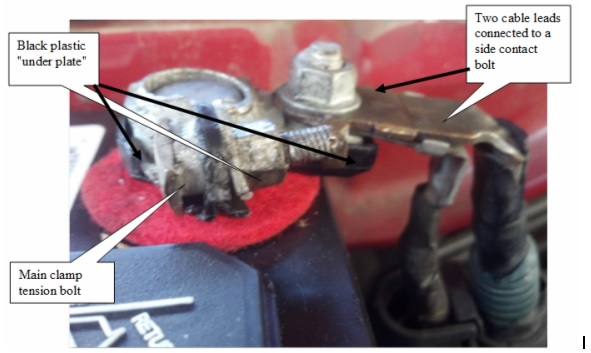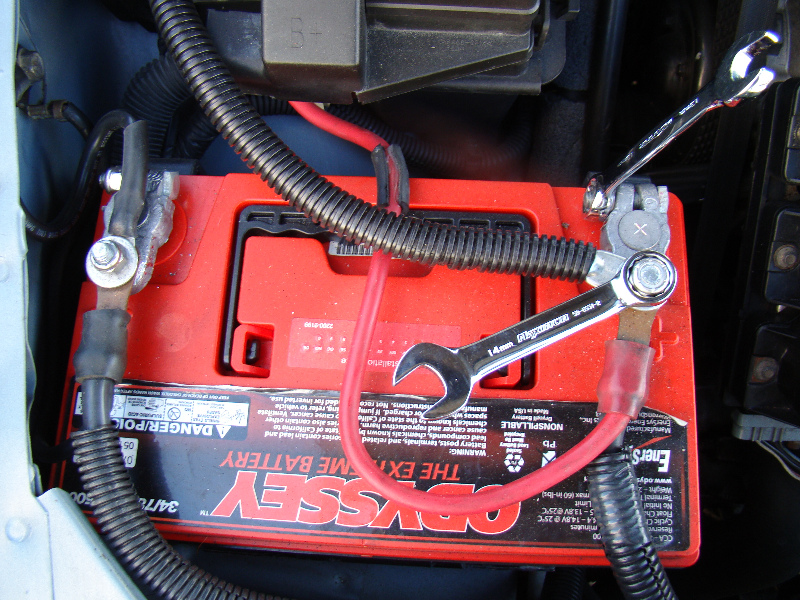How to Tighten a Battery Terminal
To tighten a battery terminal, use a wrench to secure the connection firmly. Ensuring your battery terminal is tightly secured is crucial for optimal performance of your vehicle.
Loose terminals can cause issues like starting problems or electrical malfunctions. By following a few simple steps, you can tighten the battery terminal yourself and avoid potential problems down the road. In this guide, we will walk you through the process of safely and effectively tightening a battery terminal.
Whether you are a seasoned car enthusiast or a novice DIY-er, these steps can help you maintain your vehicle and keep it running smoothly. Let’s dive in and learn how to easily tighten a battery terminal for a reliable and efficient electrical connection.

Credit: m.youtube.com
Why Should You Tighten A Battery Terminal?
When it comes to the maintenance of your vehicle, ensuring that the battery terminals are tight is essential for optimal performance. Tightening a battery terminal can prevent battery failure and ensure the electrical connections remain secure, ultimately prolonging the lifespan of your vehicle’s battery.
Preventing Battery Failure
Loose battery terminals can lead to poor electrical contact, which in turn can result in intermittent starting issues and even complete battery failure. Tightening the battery terminals is a simple yet effective way to prevent these problems and maintain a reliable power source for your vehicle.
Ensuring Electrical Connections
Tightening the battery terminals also ensures that the electrical connections remain secure, minimizing the risk of power loss and potential damage to the vehicle’s electrical system. This small effort can go a long way in maintaining the overall performance and functionality of your vehicle.

Credit: www.clublexus.com
Tools Required
To tighten a battery terminal properly, you’ll need a few essential tools and cleaning materials. These items are crucial for ensuring a secure connection and preventing any issues down the line.
Basic Hand Tools
- Socket wrench set
- Adjustable wrench
- Wire brush
Cleaning Materials
- Baking soda
- Water
- Clean cloth
Step-by-step Process
Step-by-Step Process:
Safety Precautions
Before starting, remember to wear gloves and goggles for protection.
Disconnect The Battery
- Switch off the car engine before proceeding.
- Locate the negative (-) terminal and loosen the clamp.
- Do the same for the positive (+) terminal.
Clean The Terminals
| Action | Tools Needed |
|---|---|
| Remove corrosion | Baking soda, water, wire brush |
| Clean terminals | Rag, battery terminal cleaner |
Tighten The Terminal Clamps
- Position the clamps securely on the terminals.
- Use a wrench to tighten them in place.
Reconnect The Battery
- Reattach the positive (+) terminal first, followed by the negative (-) terminal.
- Make sure the connections are firm but not over-tightened.
Tips And Troubleshooting
When dealing with a battery terminal, knowing some tips and troubleshooting techniques can come in handy. Below are some useful tips for tightening a battery terminal and troubleshooting common issues that may arise.
Using Anti-corrosion Spray
Applying anti-corrosion spray on the battery terminal can prevent future issues. This spray helps to inhibit corrosion buildup, ensuring a secure and lasting connection.
Dealing With Stubborn Connections
For stubborn connections, consider cleaning the terminal and the connector. Use a wire brush to remove any corrosion and ensure a good contact surface. Additionally, applying a coating of dielectric grease can help improve conductivity while protecting against corrosion.
Seeking Professional Help
If you encounter persistent problems or are unsure about the proper technique for tightening a battery terminal, it may be best to seek professional assistance. A certified mechanic can diagnose and resolve any underlying issues, ensuring the terminal is properly secured and functioning optimally.
Maintenance And Regular Checks
Regular maintenance and checks are essential to ensure the proper functioning of your vehicle’s battery terminals. By performing scheduled inspections and replacing worn-out terminals, you can prevent potential problems and extend the lifespan of your battery. In this section, we will discuss the importance of scheduled inspections and how to replace worn-out terminals.
Scheduled Inspection
Regularly inspecting your battery terminals is crucial in identifying any signs of corrosion or looseness. A weekly check will help you catch any issues early on and prevent further damage to your vehicle’s electrical system. To perform a scheduled inspection:
- Open the hood of your car and locate the battery.
- Visually inspect the battery terminals for any signs of corrosion, such as white or greenish deposits.
- If there is corrosion, mix a solution of baking soda and water to clean the terminals. Scrub them gently with a wire brush dipped in the solution.
- After cleaning, rinse off the terminals with water and dry them thoroughly.
- Tighten the battery terminals using a wrench or pliers until they are snugly in place. Be careful not to overtighten as it may damage the terminals.
- Ensure the terminals are securely attached to the battery posts and there is no visible movement.
- If you notice any damage or excessive corrosion that cannot be cleaned, it is recommended to replace the terminals.
Replacing Worn-out Terminals
If your battery terminals are worn-out or damaged beyond repair, replacing them is crucial to maintain a reliable electrical connection. Follow these steps to replace worn-out terminals:
- Detach the negative terminal first to prevent accidental electrical contact.
- Use a wrench or pliers to loosen the terminal nut.
- Remove the old terminal from the battery post.
- Clean the battery post with a wire brush or sandpaper to remove any corrosion or debris.
- Attach the new terminal to the battery post and hand-tighten the nut.
- Use a wrench to securely tighten the terminal nut. Take care not to overtighten to avoid damage.
- Repeat the process for the positive terminal.
- Once both terminals are securely attached, perform a visual inspection to ensure there is no movement or looseness.
By regularly inspecting your battery terminals and replacing worn-out ones when necessary, you can maintain a reliable electrical connection and prevent potential battery issues. Remember to always follow safety precautions while working with batteries and consult a professional if you are unsure.

Credit: www.gmforum.com
Frequently Asked Questions On How To Tighten A Battery Terminal
How Do You Tighten A Loose Battery Terminal?
To tighten a loose battery terminal, follow these steps: 1. Turn off the engine and remove the negative cable from the terminal. 2. Clean the terminal and cable ends with a wire brush to remove any dirt or corrosion. 3. Place the cable back onto the terminal and tighten the nut securely.
4. Ensure the connection is snug and not able to move. 5. Finally, start the engine to check if the connection is secure and working properly.
What Tool To Use To Tighten Battery Terminals?
Use a wrench or socket to tighten battery terminals securely. Regular maintenance can prevent loose connections.
How Tight Should A Battery Terminal Be?
Tighten battery terminals securely without over-tightening to prevent damage. Use a torque wrench to ensure proper tightness.
Is It Safe To Tighten A Car Battery?
Yes, it is safe to tighten a car battery to prevent loose connections and ensure proper electrical conductivity.
How Do You Tighten A Battery Terminal?
To tighten a battery terminal, use a wrench to securely fasten the nut on the terminal post, ensuring a snug fit.
What Happens If Battery Terminals Are Loose?
Loose battery terminals can cause poor electrical connections, leading to starting issues, intermittent power, or even damage to the battery or electrical system.
Why Is It Important To Tighten Battery Terminals?
Tightening battery terminals ensures a solid electrical connection, preventing power loss and potential damage to the battery or electrical components.
Conclusion
Keeping your battery terminals tight is essential for the efficient functioning of your vehicle. By following the simple steps outlined in this blog post, you can ensure that your battery remains secure and keeps your car running smoothly. Take the time to regularly inspect and tighten your battery terminals to prevent any potential issues down the road.

